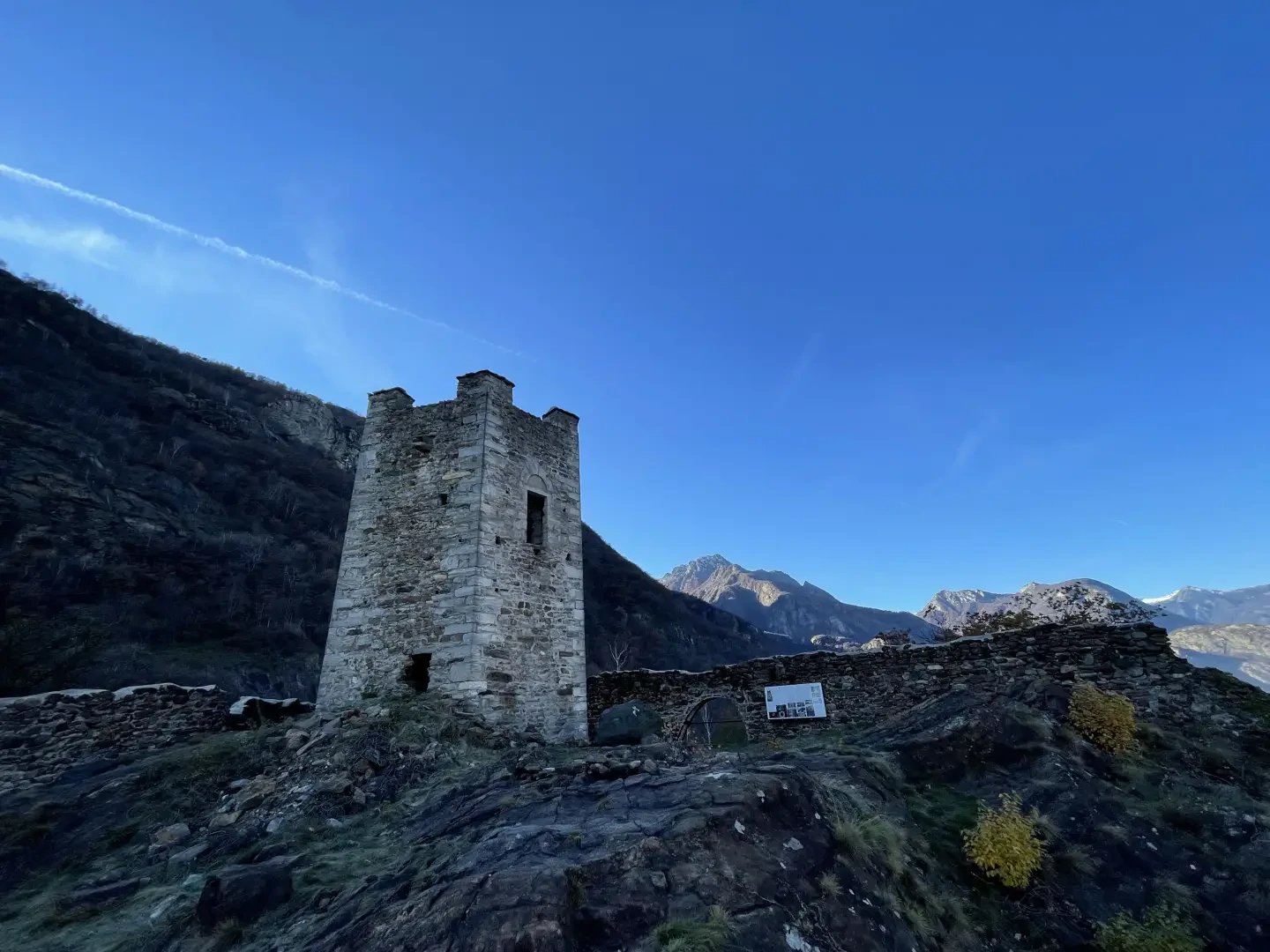Pramotton Tower

Introduction
The Pramotton Tower, which stands like a sentinel on the right bank of the Dora on the border with the lands of Ivrea, is located in Vert, a hamlet of Donnas, in a place that the historian J. B. de Tillier in his 'Historique de la Vallée d'Aoste' described as one of the valley's characteristic points at the time of the first 'heroic' passengers heading for Italy:
.Description
"C'est donc a ce fameux heros que la posterité à l'obligation d'avoir rendu aisée, dans cette premiere advenue du costé d'Italie, une route qui ne pouvoit etre auparavant que rebutante et tres penible, puis qu'elle traversoit, a ce qu'on croit, par la hauteur des montagnes, depuis le lieu de Vert et de Champorcher, a Fenis et a Saint Marcel, parce que l'on y decouvre aussi del pavés et autres vestigies, des grands chemins qui donnent quelque probabilitté a cette tradition".
(It is therefore to these famous heroes that posterity has the obligation of gratitude for having made practicable, in these first journeys towards Italy, a road that before could only present itself inhospitable and challenging, as it was believed, in the midst of high mountains, after the places of Vert and Champorcher, Fénis and Saint-Marcel, because pavings and other vestiges of great roads are found here that give some probability to this tradition).
Architectural Description
The Pramotton Tower, the first in the Val d'Aosta for those arriving from the Canavese plain, stands on a rocky promontory and can be reached by a good walk.
The tower has a hexagonal plan, with the corners made of large squared ashlars and the walls of smaller stones; this fact makes plausible the hypothesis that the tower was built by reusing salvaged material from a previous tower.
The hexagonal tower typology is decidedly unusual and can be motivated not only by the need to make the best possible use of salvaged material, but also by the fact that the number of corners, intermediate between four and eight, appears more calibrated, and we could say technically optimal by virtue of the material available. The hexagonal plan can be found not only in the Pramotton Tower, but also and only (if we refer to the Valdostan area) in a room of the castle of Point-Saint-Martin.
The tower has only six battlements, corresponding to the six corners, and was surrounded on the most vulnerable sides by a defensive curtain of which some traces are still visible.
The entrance door to the Tower is about four metres above the ground; internally, the Tower was divided by wooden floors.
Historical Background
Historically, the Pramotton Tower, also known as the Bellegarde Tower or Torre d'Aviès (= d'avis), originally belonged to the Royal Mandate of Bard; in 1214 it was divided between Hugh of Bard and his brother William of Pont-Saint-Martin, with the former's rightful claim. It seems that, when the latter lost the feud in 1242, the Tower reverted to the Savoys, but there is a document dated 1277, noting an agreement between the lords of Pont-Saint-Martin and Philip of Savoy, which throws a wrench into the history of this building. In fact, it appears that the tower had been built only a short time before: "[...] sur la bastie nouvellement edifiée d'ordre dudit comte au dessus de Donnas". In reality, it is hardly correct to assume that the construction (bastie) was built ex-novo; instead, it is more credible that an earlier tower existed in Vert with the function of sending signals back to the castle of Pont-Saint-Martin. An examination of the masonry structures allows us to say that the present tower, built in the second half of the 12th century, was constructed with salvaged material, most probably from the pre-existing one.
The tower was equipped with a garrison of armed men ready to intervene in the event of danger, as happened in 1293, when the Marquis of Monferrato threatened the Lower Valley, and in 1386, when the castellan of Bard sent two people for a month (in garnisone et custodia, ne Tuchini de valle Brocii ipsam caperent) to prevent it from falling into the hands of the Tuchini (the Tuchini were the protagonists of a spontaneous popular insurrection that flared up in the Canavese area, starting from Ivrea, between 1386 and 1391, against the oppression of the local nobles and the tax burden they exerted, above all tolerance, in order to finance the struggles for domination over the region; the rioters' motto was 'Tucc'un' from which the term Tuchino derives).